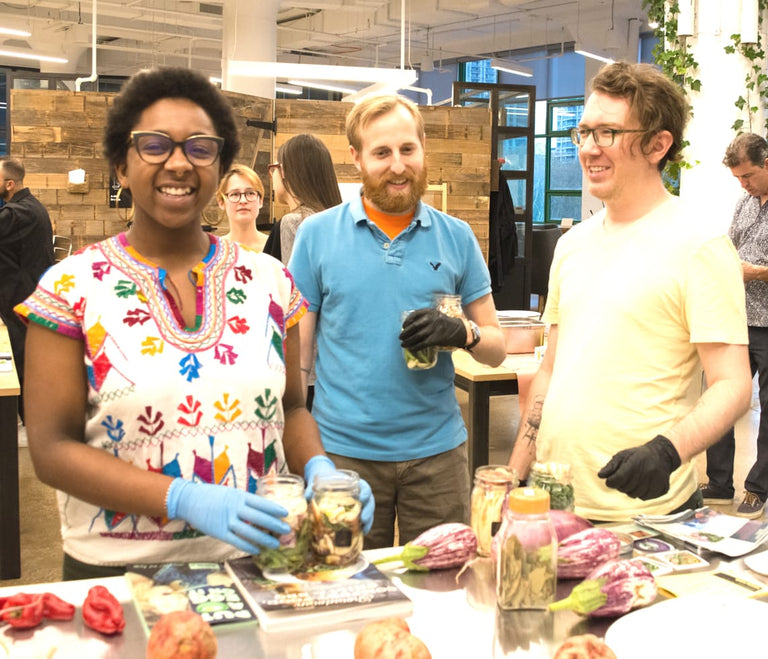Hot Potato(es)!
By Jessica Kulick, Local Roots subscriber + food lover
Potatoes are truly an unsung hero of kitchens the world over. Whether mashed, baked, roasted, fried, sautéed, or steamed, the sheer versatility of this humble tuber is something to be celebrated. But which spud to choose for the job? If you’re scratching your head wondering which variety to use for a first-rate french fry or more masterly latkes, look no further—your comprehensive guide to all things potatoes is here.
Types of Potatoes & When to Use Them
Firstly, potatoes fall into three basic categories: waxy, starchy, and all-purpose. Waxy potatoes are low in starch content and have firm yet moist flesh that tends to hold its shape after cooking. Varieties like Red Bliss, Adirondack Blue, and Fingerling should be your go-to (go-tuber?!) for roasting, or perfecting your summer potato salad recipe. Starchy potatoes are—you guessed it—higher in starch content and lower in moisture, which means that they won’t hold their shape as well as waxy types do. Idaho Russet and Katahdin fall into this group, making them great for boiling and frying. Finally, all-purpose potatoes are pretty much what they sound like: a medium starchy potato that can be used in just about any recipe. Yukon Gold, Norland Red, Purple Majesty, and Kennebec are all phenomenally multi-purpose.
While the nutritional difference between the three types is negligible—they’re all low in calories, high in fiber, and contain zero fat or cholesterol—some food scientists posit that potatoes with more richly-colored skin and flesh are higher in flavonoids, which can protect your cells from oxidative damage.
Sweet Potatoes vs. Yams
Thanks to egregious mislabeling by grocery stores across the country, there seems to be quite a bit of confusion amongst home cooks about sweet potatoes and yams. Are they tater twins...or not? While their names are often used interchangeably, sweet potatoes and yams are not the same. They don’t even have that much in common! Sweet potatoes are grown across the Unites States, belong to the same family as morning glory flowers, and have an elongated shape with tapered ends. Their skin can be white, red, yellow, purple, or brown, and their flesh can be white, yellow, or orange.

Yams, on the other hand, are native to Africa and Asia, related to lilies, and have a cylindrical shape. Their skin is usually black or brown with white, purple, or red flesh. Yams have been known to grow up to five feet long!
Thanks to the knowledge of our farmers and producers, you’ll always know exactly what you’re getting in your Local Roots vegetable share. But to avoid any potential uncertainty at the grocery store, here’s a quick tip: there are actually two kinds of sweet potatoes. There’s firm, which have brown skin and white flesh, and then there’s soft, which have reddish skin and orange flesh. (True yams are actually pretty hard to find in the U.S.) Supermarkets have taken to labeling soft sweet potatoes as yams, which got us into this mess into the first place.
When cooking at home, use the firm kind for the ideal baked potato: all crispy skin on the outside and fluffy on the inside. Recreating Grandma’s Thanksgiving casserole? Reach for the soft sweet potatoes—their orange flesh will be picture-perfect underneath all that marshmallow-y goodness.
Home Storage & Recipe Ideas
Potatoes are already long-lasting, but storing them properly helps improve their staying power and will ensure optimal flavor. While they don’t need to be refrigerated, they do prefer cool, dark places: an unheated basement between 45-50° F is just right for these economical veggies. Don’t have a root cellar in your tiny NYC apartment? (Hah! Me neither.) Try storing them in a paper bag, cardboard box, mesh bag, or basket on your kitchen table. If you brought them home in plastic, be sure to remove it as soon as you get home, as the plastic will shorten their shelf life considerably.
Finally, keep your potatoes away from other produce, especially onions! Both release gases that ripen the other.
Looking for a little ‘tato inspo? I’ve rounded up a few fave recipes from around the web, as well as from our own amazing bloggers. Happy cooking!
- Cheesy Potato Soup
- Cheesy Potato & Kale Gratin
- Duchess Baked Potatoes
- Kielbasa, Sauerkraut, & Potato Pierogies
- Leek & Potato Frittata
- Lentil & Potato Stew
- Silver Dollar Latkes
- Sweet Potato Tempura
- Sweet Potato Veggie Burgers
- Sweet Potato, Parsnips, & Turnip Latkes
- Triple-Cooked Fries
Rather have a taste first?
Local Roots Experiences are fun, pop-up events where we bring the farm to you!

Become a Harvest Club Pick Up Location
Are you a NY based cafe, bar, or neighborhood business? Become a Harvest Club pick up location and have community members come to your establishment each week to pick up their Local Roots harvest.
Top







